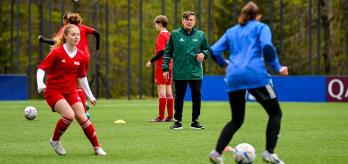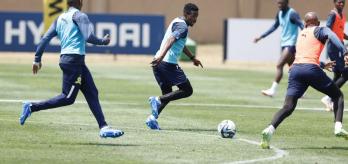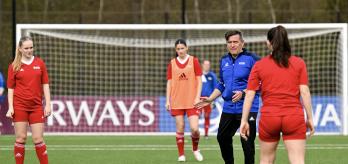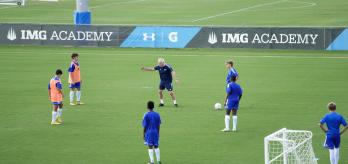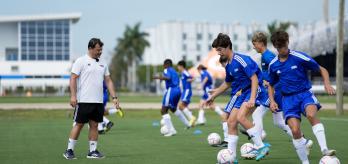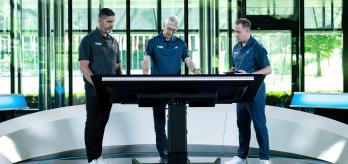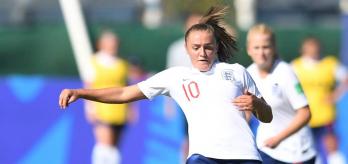This session begins in the classroom with Francesco Gabriele, head of youth development for the Swiss Football Association and the coach of Switzerland’s U-18 national team. After analysing several video clips of successful attack-building, he takes the group outside for three activities designed to simulate an attack against a high block: first, players practise finding an open team-mate in a small-sided "micro situation," then expand to a larger set-up, and conclude with a game where they must apply the principles that they have learned.
Session overview
- Part 1: Classroom session.
- Part 2: Micro situation - 4v4 + 2 goalkeepers and 1 joker.
- Part 3: Macro situation - 9v9 with 2 goalkeepers.
- Part 4: Large game - 10v10 on a reduced pitch
Key coaching points
- When the opposition presses a goalkeeper who is playing the ball out, there will always be a free player on the goalkeeper's team elsewhere on the pitch. The objective for the team playing the ball out is to get the ball to the free player and play forward.
- If the goalkeeper cannot play the ball directly to the free player, the team must work together to find solutions – usually through the use of a third player – to find the free one.
- Once the free player receives the ball, the team in possession should accelerate and create an attack, with the ultimate aim of scoring a goal.
- Since a goalkeeper's involvement is integral to playing out from the back, it is vital that they are vocal during the session and confident both with and without the ball.
- When building up from the back, the team in possession must look to create overloads in midfield through movement into open spaces, positional changes and passing triangles.
- Recognising space and moving into it can draw opposition players out of position, creating more room for the ball to be moved into more attacking areas of the pitch. Players should be conscious of this during the session.
Part 1: Classroom session
Francesco Gabriele presents his players with a problem: what do you do when you have the ball in your defensive third, and your opponents are aggressively pressuring you to force a turnover? It is possible to move the attack forward in this situation, but players need to work together:
- Actively involve the goalkeeper in the attack.
- Be confident; do not rush to clear the ball into midfield.
- Always be looking for an open team-mate – scan the whole pitch!
- Circulate the ball to create overload situations.
- Use three-player combinations.
- Identify open spaces and immediately accelerate into them.
Part 2: 4v4 + 2 goalkeepers and 1 joker

This small-sided exercise strips the game situation down so that players can focus on the essentials: creating space, finding the open player, creating overloads, and accelerating forward to score.
-
Mark out a 20x26m pitch with 5m end zones.
-
Place 2 small goals on each end line.
-
Divide the players into 2 teams of 4 plus 2 goalkeepers and 1 joker (neutral player), who helps whichever team has the ball.
-
Mark out an identical second pitch, also with 2 small goals on each end line.
-
On the second pitch, divide the remaining players into 2 teams of 4 with 1 joker and without goalkeepers.
-
Play begins with a pass from the coach.
-
Teams play 4v4 + 2 GKs with 1 joker and no offside. The attacking team try to keep possession, pass to the free player, attack the end zone and then score.
-
The goalkeepers can only defend the end zones, not the goals themselves.
-
Teams play 5v5 + 2 goalkeepers with 1 joker.
-
Individual tactics: when receiving the ball, scan the whole pitch and try to maintain an open position so you can take the ball in a few different directions. Once you have the ball, take your first touch forward and stay focused on the goal – only pass back if you have no forward options.
-
Group tactics: actively involve the goalkeeper in your attack. Do not form lines – spread out so that the ball carrier has multiple receivers to choose from. Make vertical runs to open up space for penetrating passes. Find the free player and then play forward with intent.
-
Technique: passes should be as precise as possible and only as hard as necessary. Always aim for the receiver’s front foot. On overloads, keep your touches to a minimum (ideally no more than 2) to take advantage before your opponents have a chance to regroup.
Part 3: 9v9 with 2 goalkeepers

This exercise takes the situation introduced in the previous exercise and expands it to a larger pitch with bigger teams. As before, the focus is on finding space and team-mates to create overloads, with an extra incentive to score goals quickly and directly.
-
Mark out a 40x50m pitch with 10-12m end zones.
-
Place 2 small goals on each end line.
-
Divide players into 2 teams of 9 plus 2 goalkeepers.
-
Play begins with a pass from the coach.
-
Teams play 9v9 plus 2 goalkeepers, with no offside. The attacking team try to keep possession, pass to the free player, attack the end zone and then score.
-
The goalkeepers can only defend the end zones, not the goals themselves.
-
Goals scored from direct balls count double.
-
Teams play 8v8 or 10v10 plus 2 goalkeepers.
-
Add 1 or 2 neutral players to focus on overload situations in midfield.
-
Individual tactics:
-
Always look for spaces downfield, in behind your opponents, and run into them to open things up and escape the pressure.
-
When you get the ball, play it into those spaces on your first touch.
-
-
Group tactics:
-
When under pressure, the team in possession should aim to build up and find solutions that let them get the ball to the free player.
-
Actively involve the goalkeeper to initiate and be part of the build-up. Based on the opposition's pressing strategy, the GK needs to decide how to start the build-up. Coordinate with team-mates to make runs in opposite directions (one drops back, the other moves forward).
-
Try to shift the point of attack to the other side whenever possible, using penetrating diagonal balls to gain space and time.
-
Part 4: 10v10 on reduced pitch

The concluding game is a 9v9 on a three-quarter pitch to help players get used to high-pressure situations. This is their opportunity to apply all the skills they have been practising, including checking away from opponents to get open and creating overloads in regular play.
-
Mark out a pitch that is three quarters the size of a regular one, with a regular-sized goal on each end line.
-
Divide the players into 2 teams of 9, including goalkeepers.
-
Play begins with the attacking team's goalkeeper playing the ball out from the back.
-
The attacking team try to create overload situations and move the attack forward.
-
The defending team should press high up the pitch.
-
Teams can play 11v11 or 10v10, including goalkeepers.
4 steps to break a high press
-
First, show for short passes at top speed; this ties up opponents while simultaneously buying you time.
-
Next, run into the spaces that have now opened up behind the opposition.
-
Now take advantage of the other team’s disorganised state with a quick, well-aimed through-ball.
-
Finally, move up with the ball to create overload situations in the middle or on the wing.
















